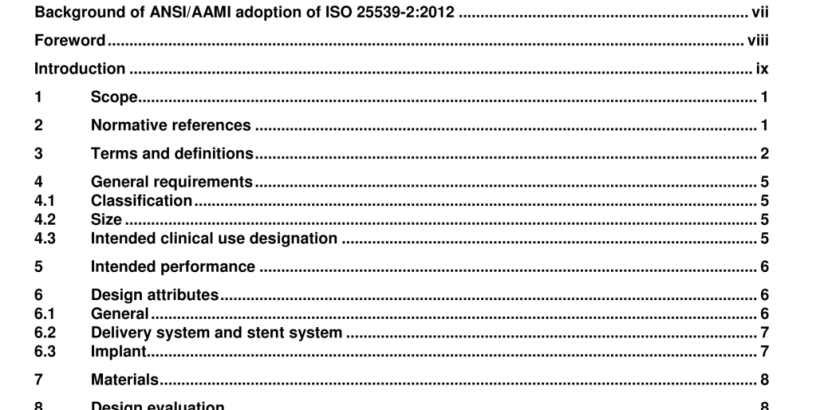ANSI AAMI ISO 25539-2-2012 pdf download
ANSI AAMI ISO 25539-2-2012 pdf download.Cardiovascular implants – Endovascular devices
1 Scope
1.1 This part of ISO 25539 specifies requirements for vascular stents, based upon current medical knowledge. With regard to safety, it gives requirements for intended performance, design attributes, materials, design evaluation, manufacturing, sterilization, packaging and information supplied by the manufacturer. It should be considered as a supplement to ISO 14630,which specifies general requirements for the performance of non-active surgical implants. NOTE Due to the variations in the design of implants covered by this part of ISO 25539 and in some cases due to the relatively recent development of some of these implants (e.g. bioabsorbable stents, polymeric stents), acceptable standardized in vitro tests and clinical results are not always available. As further scientific and clinical data become available, appropriate revision of this part of ISO 25539 will be necessary.
1.2 The scope of this part of ISO 25539 includes vascular stents used to treat vascular lesions or stenosis,or other vascular abnormalities. These devices might or might not incorporate surface modifications of the stent such as drug and/or other coatings. Stents covered with materials that significantly modify the permeability of the uncovered stent are within the scope of ISO 25539-1. The stent design might dictate the need to address functional requirements identified in both ISO 25539-1 and this part of ISO 25539.
1.3 Delivery systems are included in this part of ISO 25539 if they comprise an integral component of the deployment of the vascular stent.
1.4 Procedures and devices used prior to the introduction of the vascular stent, such as ballon angioplasty devices, are excluded from the scope of this part of ISO 25539.
1.5 Some pharmacological aspects of drug-eluting stents are addressed in this part of ISO 25539, but this part of ISO 25539 is not comprehensive with respect to the pharmacological evaluation of drug- eluting stents.
1.6 Degradation and other time-dependent aspects of bioabsorbable and polymeric stents and coatings are not addressed by this part of ISO 25539.
1.7 With the exception of sterilization, this part of ISO 25539 does not address requirements for the evaluation of animal tissue products.
7 Materials
The requirements for materials of ISO 14630:2012, Clause 6, apply. Additional testing specific to certain materials (e.g. metals, polymers, drugs) shall be performed to determine the appropriateness of the material for use in the design. For example, Nitinol materials dependent on shape memory properties shall be subjected to testing in order to assess transformation properties. In addition, for drug-eluting stents drug identity testing shall be performed, including the identification of impurities and degradants. Electro-chemical potentials of differing metals (stents, guidewires, other accessory devices) might require additional types of testing.
It is impossible to take into consideration all future and emerging technologies. The stent systems based on these new technologies will need to be evaluated following the basic requirements of this part of ISO 25539. Testing beyond the scope of this part of ISO 25539 might also be necessary in order to characterize these stent systems. Consideration shall be given to the failure modes of the stent systems and their effects on the performance of the implant in identifying the appropriate testing. Whenever changes are made in materials, construction, configuration, application or processing methods, an appropriate analysis of the potential impact of the change on the failure modes and performance of the stent system shall be performed. Appropriate testing shall be conducted as deemed necessary. The use of a control device for comparison should be considered in the evaluation of certain design attributes. If overlapping of stents can be anticipated in clinical use (e.g. superficial femoral artery, coronary), integrity of the stent under study in overlapping configurations should be evaluated, unless justification can be provided for testing of individual stents. If overlapping with a different device is specifically indicated, testing should include evaluation with the indicated device. Testing to establish the labeled shel-life shall be conducted by repeating appropriate tests. Justification for the selection of tests shall be provided. For drug-eluting stents, real time and accelerated testing conditions should be used to define drug attributes for product shelf life.
